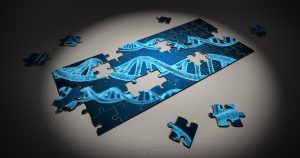
Last week, I discussed how essential oils are able to act as environmental influencers to alter our cellular functions at the DNA level. This is known as epigenetics. Many people who are savvy health blog followers have heard of this term, but may be confused by what it is.
According to the National Institutes of Health (NIH), “DNA, or deoxyribonucleic acid, is the hereditary material in humans and almost all other organisms.” It stores our biological information and the genetic instructions on growth, reproduction, and other living processes. Epigenetics explains how our DNA can be altered by outside factors.
NIH states the precise definition as follows:
DNA modifications that do not change the DNA sequence can affect gene activity. Chemical compounds that are added to single genes can regulate their activity; these modifications are known as epigenetic changes. The epigenome comprises all of the chemical compounds that have been added to the entirety of one’s DNA (genome) as a way to regulate the activity (expression) of all the genes within the genome. The chemical compounds of the epigenome are not part of the DNA sequence, but are on or attached to DNA (“epi-“ means above in Greek). Epigenetic modifications remain as cells divide and in some cases can be inherited through the generations. Environmental influences, such as a person’s diet and exposure to pollutants, can also impact the epigenome.
Epigenetic changes can help determine whether genes are turned on or off and can influence the production of proteins in certain cells, ensuring that only necessary proteins are produced. For example, proteins that promote bone growth are not produced in muscle cells. Patterns of epigenetic modification vary among individuals, different tissues within an individual, and even different cells.
A Simply Analogy of Epigenetics
![]()
Now, here is a simple, non-scientific analogy comparing our body’s blueprint for life interacting with environmental factors to a computer’s hardware communicating with its operating system.
If you think of your DNA as the computer’s hardware, it contains all the necessary parts and pieces to allow the machine to run, process, and store information in its hard drive. Some lucky machines have been built more “robust” with touch-screens, quad cores, higher storage capacities, and other techy terms I am unfamiliar with, but in general, all computers have the same basic parts in order to be a functioning machine. Now, in order to access and obtain information on the computer, save it, and work with its apps, you need an operating system, whether it be iOS or Office. The better the software, the better the machine works. You want to make sure you are updating and upgrading regularly with helpful resources, so you can have an optimally running machine. However, if your computer gets a virus, or if its been damaged (such as my 2016 “hot cocoa on the computer incident”), the machine malfunctions.
In my article,I cited several reviews that highlighted how essential oils modulate specific cellular pathways relating to immune modifying effects. Like other holistic methods, they can act in multifaceted ways to keep our operating systems in-tune including:
- microbe inhibition
- microbiome support
- cellular defense and repair
- immunoregulatory actions
- emotional, biological, and physiological effects on enzymes and hormone pathways, modulating systemic responses
- addressing preventative and causative factors contributing to autoimmunity
Recently, a 2016 in vitro review, Effects of Essential Oils on Telomere Length in Human Cells, provided some evidence that essential oils may also help with preventing cellular dysregulation due to aging. (Wiki states: A telomere is a region of repetitive nucleotide sequences at each end of a chromosome (a DNA molecule with genetic material), which protects the end of the chromosome from deterioration or from fusion with neighboring chromosomes.)
The researchers tested the effect of 31 essential oils on cellular aging markers in the presence and absence of oxidative stress. The results demonstrated that certain essential oils could influence damage on telomeres. (Note, that the essential oils that did not positively impact telomeres in vitro still have reported health benefits that may modulate cellular response in other ways. See above.)
The abstract states, in scientific jargon for my fellow geeks, the following (you can also skip to the conclusion if you prefer):
Essential oils are used for their reputed health benefits; reversal of inflammation, oxidative damage, and infection are some of the therapeutic effects that essential oils are believed to possess. In many cases, there is scientific evidence to back these claims. However, the purported anti-aging effects of essential oils are not yet supported by the literature. We set out to evaluate the effects of 31 oils on telomere length, believed to play a role in cellular senescence. Cells were subjected to oils in the presence or absence of hydrogen peroxide, and changes in telomere length were measured using a PCR-based assay. Two oils which showed telomere-protective effects were further characterized using a cytogenetic assay, staining for telomeres. Significant variability was seen among these oils with respect to their ability to induce an apparent increase or decrease in telomere length, and to protect against peroxideinduced telomere damage. Expression analysis showed that telomere-protective oils did not increase telomerase (hTERT) gene transcription, but reduced TERF-1, a suppressor of telomere length. Though this mechanism is not yet understood, these data provide a base upon which the community can build, and represent the first formal scientific foray into the study of essential oils on the telomere.
Conclusion: Certain essential oils, including those from basil and rosemary, appear to have telomere-protective effects, mediated through a reduction of the TERF-1 telomere-suppressive protein.
Summary
These results provide more evidence of the versatile actions of essential oils on various cellular pathways to support our health. Now, click to read more on this subject on my homepage blog, Essential Oils and Immune & Cellular Modulation- The Epigenetics of Essential Oils: Part II.
Disclaimer: This information is applicable ONLY for therapeutic quality essential oils. This information DOES NOT apply to essential oils that have not been tested for purity and standardized constituents. There is no quality control in the United States, and oils labeled as “100% pure” need only to contain 5% of the actual oil. The rest of the bottle can be filled with fillers and sometimes toxic ingredients that can irritate the skin. The studies are not based solely on a specific brand of an essential oil, unless stated. Please read the full study for more information.
This material is for information purposes only and is not intended to diagnose, treat, or prescribe for any illness. You should check with your doctor regarding implementing any new strategies into your wellness regime. These statements have not been evaluated by the FDA. (Affiliation link.)
Thanks Pixabay.



